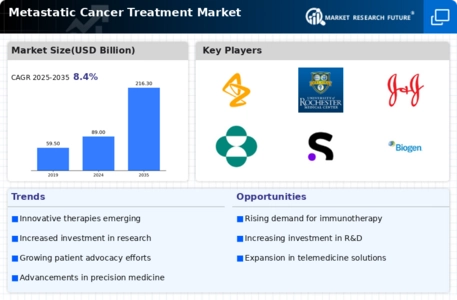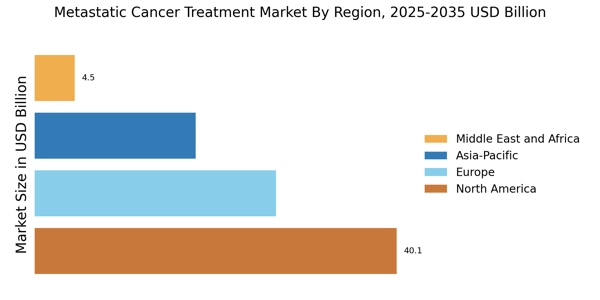Growing Demand for Immunotherapy
The growing demand for immunotherapy is reshaping the Metastatic Cancer Treatment Market. Immunotherapy, which harnesses the body's immune system to fight cancer, has gained traction due to its potential to provide durable responses in patients with metastatic disease. Recent approvals of immune checkpoint inhibitors and CAR T-cell therapies have revolutionized treatment paradigms, leading to increased interest from both clinicians and patients. The market for immunotherapy is projected to expand significantly, as ongoing clinical trials continue to explore its efficacy across various cancer types. This shift towards immunotherapeutic approaches is likely to drive innovation and competition within the Metastatic Cancer Treatment Market, as stakeholders strive to develop next-generation therapies that can improve patient outcomes.
Advancements in Targeted Therapies
Advancements in targeted therapies represent a crucial driver for the Metastatic Cancer Treatment Market. These therapies, which focus on specific molecular targets associated with cancer, have shown promising results in improving patient outcomes. The market has witnessed a surge in the development of targeted agents, such as monoclonal antibodies and small molecule inhibitors, which have been effective in treating various metastatic cancers. For instance, the introduction of targeted therapies has led to improved survival rates in patients with specific genetic mutations. As research continues to unveil new targets, the potential for novel therapies to enter the market remains high. This ongoing innovation is likely to enhance the treatment landscape, thereby driving growth in the Metastatic Cancer Treatment Market as healthcare providers seek to offer personalized treatment options.
Rising Incidence of Metastatic Cancer
The increasing incidence of metastatic cancer is a primary driver for the Metastatic Cancer Treatment Market. As cancer rates continue to rise, the demand for effective treatment options escalates. According to recent statistics, metastatic cancer accounts for a significant proportion of cancer-related deaths, which underscores the urgency for innovative therapies. This trend is likely to propel investments in research and development, as pharmaceutical companies seek to address the unmet needs of patients. Furthermore, the growing awareness of cancer screening and early detection may lead to more cases being diagnosed at advanced stages, thereby increasing the patient population requiring metastatic cancer treatments. Consequently, this rising incidence is expected to stimulate growth within the Metastatic Cancer Treatment Market, as stakeholders strive to develop and deliver effective solutions.
Increased Investment in Cancer Research
Increased investment in cancer research is a significant driver for the Metastatic Cancer Treatment Market. Governments, private organizations, and pharmaceutical companies are allocating substantial resources to understand the complexities of metastatic cancer. This influx of funding is facilitating the development of new treatment modalities, including immunotherapies and combination therapies, which have shown potential in clinical trials. For example, the National Cancer Institute has reported a rise in funding for research initiatives aimed at understanding metastatic pathways, which could lead to breakthroughs in treatment. As more effective therapies are developed, the market is expected to expand, providing patients with a broader range of options. This trend indicates a robust commitment to combating metastatic cancer, ultimately driving growth within the Metastatic Cancer Treatment Market.
Regulatory Support for Innovative Treatments
Regulatory support for innovative treatments is a vital driver for the Metastatic Cancer Treatment Market. Regulatory agencies are increasingly adopting frameworks that expedite the approval process for novel therapies, particularly those addressing unmet medical needs in metastatic cancer. Initiatives such as breakthrough therapy designations and accelerated approval pathways are encouraging pharmaceutical companies to invest in research and development. This supportive regulatory environment is likely to facilitate the entry of new treatments into the market, thereby enhancing the options available to patients. As more innovative therapies receive approval, the Metastatic Cancer Treatment Market is expected to experience growth, driven by the introduction of cutting-edge solutions that aim to improve survival rates and quality of life for patients.


















Leave a Comment